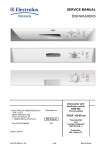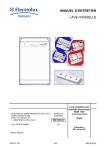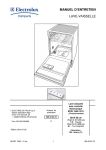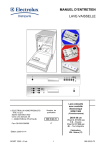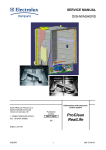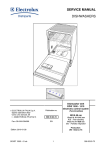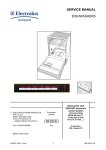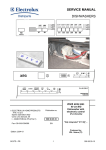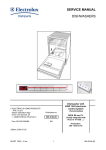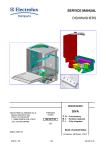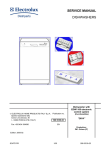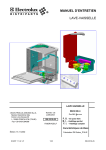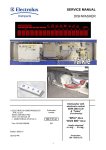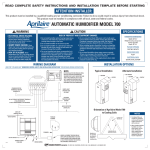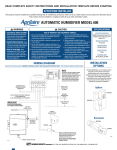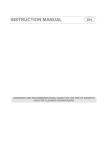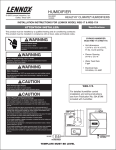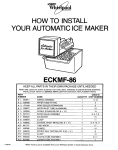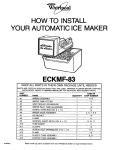Download SERVICE MANUAL DISHWASHERS - M
Transcript
SERVICE MANUAL DISHWASHERS ELECTROLUX HOME PRODUCTS ITALY S.p.A. Spares Operations Italy Corso Lino Zanussi, 30 I - 33080 PORCIA /PN (ITALY) Fax +39 0434 394096 Publication no. (Functionalities) “DIVA” 45-60-BIG 599 36 83-66 EN Edition: 2005-02 SOI/TD 2005-2 PR Dishwasher with electronic control EDW 503 “totally integrated” 911639… 911939… 911689… 911989… Production: ZM - Solaro (IT) 1 /26 599 36 83-66 SOI/TD 2005-2 PR 2 /26 599 36 83-66 CONTENTS 1 2 3 4 Purpose of this manual ................................................................................................................................ 5 PRECAUTIONS ........................................................................................................................................... 5 GENERAL CHARACTERISTICS................................................................................................................. 5 CONTROL PANEL....................................................................................................................................... 6 4.1 On/Off button (S0).............................................................................................................................. 6 4.2 Option selection button (S1) .............................................................................................................. 6 4.3 Programme selection button (S2) ...................................................................................................... 6 4.4 Options............................................................................................................................................... 7 4.4.1 4.4.2 “1/2 load”.....................................................................................................................................................7 Delayed start...............................................................................................................................................7 4.5 Cancelling a programme.................................................................................................................... 7 4.6 Interruption of a programme (pause) ................................................................................................. 7 4.7 Power failure ...................................................................................................................................... 7 5 SEQUENCE OF OPERATION..................................................................................................................... 8 6 HYDRAULIC CIRCUIT................................................................................................................................. 9 7 ELECTRICAL COMPONENTS AND FUNCTIONS ................................................................................... 10 7.1 EDW503 Electronic control system ................................................................................................. 10 7.1.1 7.1.2 7.2 Functions of the circuit board ....................................................................................................................10 Memory in the control system ...................................................................................................................11 Specifications for actuators and sensors ......................................................................................... 11 7.2.1 7.2.2 7.3 7.4 Components..............................................................................................................................................11 Sensors.....................................................................................................................................................11 Power supply and programme selection.......................................................................................... 12 Fill circuit .......................................................................................................................................... 12 7.4.1 7.4.2 7.4.3 7.4.4 7.5 Level and anti-overflow pressure switch ...................................................................................................12 Fill system .................................................................................................................................................12 Anti-flooding device...................................................................................................................................12 Intervention of the anti-overflow system....................................................................................................12 Control of water fill phase ................................................................................................................ 12 7.5.1 7.5.2 7.5.3 7.6 Static fill ....................................................................................................................................................12 Dynamic fill................................................................................................................................................12 Level stability control.................................................................................................................................12 Water fill time ................................................................................................................................... 13 7.6.1 7.6.2 7.6.3 7.7 7.8 Static fill time.............................................................................................................................................13 Dynamic fill time........................................................................................................................................13 Power supply interruption during water fill ................................................................................................13 Level stability during washing .......................................................................................................... 13 Washing system............................................................................................................................... 13 7.8.1 7.9 7.10 7.11 Control of the washing pump ....................................................................................................................13 Heating............................................................................................................................................. 13 Integrated detergent dispenser........................................................................................................ 14 Drain................................................................................................................................................. 14 7.11.1 Siphon” effect............................................................................................................................................14 7.12 Regeneration system ....................................................................................................................... 15 7.13 Resin washing.................................................................................................................................. 15 7.14 Blending” function ............................................................................................................................ 15 8 DRYING ..................................................................................................................................................... 16 9 ALARMS..................................................................................................................................................... 17 9.1 Table of alarm codes ....................................................................................................................... 17 10 USER MODE ............................................................................................................................................. 19 10.1 Regeneration selection .................................................................................................................... 19 10.2 Buzzer.............................................................................................................................................. 19 11 SERVICE MODE........................................................................................................................................ 20 11.1 Reading the alarms and activating the individual components ....................................................... 20 11.2 Cancelling alarm codes from memory / test of LEDs ...................................................................... 20 11.3 Functional testing cycle.................................................................................................................... 21 11.3.1 11.3.2 Selecting the cycle ....................................................................................................................................21 Cycle phases ............................................................................................................................................21 11.4 Exiting Service and User modes...................................................................................................... 21 12 ELECTRICAL FUNCTIONS ....................................................................................................................... 22 12.1 Electrical circuit diagram .................................................................................................................. 22 12.2 Basic circuit diagram........................................................................................................................ 23 12.2.1 Key to circuit diagram ...............................................................................................................................23 13 TABLE OF PROGRAMMES ...................................................................................................................... 24 SOI/TD 2005-2 PR 3 /26 599 36 83-66 14 CHECKING THE EFFICIENCY OF THE COMPONENTS ........................................................................ 25 14.1 Measurement points on the board wiring connectors...................................................................... 25 15 QUICK GUIDE TO THE SPECIAL FUNCTIONS....................................................................................... 26 SOI/TD 2005-2 PR 4 /26 599 36 83-66 1 Purpose of this manual The purpose of this manual is to provide service personnel (who already have the basic knowledge necessary for repairing dishwashers) with information on dishwashers equipped with the EDW503 electronic control system, which are produced in the Solaro (MI - Italy) factory. The EDW503 control system consists of a main circuit board and a control/display board. Both boards are housed in a single plastic container. It is used in some “DIVA” models. This Manual describes: • General characteristics • Control panel and programmes • Technical characteristics • Guide to diagnostics For more detailed information regarding the hydraulic circuits and the structural characteristics of the appliances, refer to the Service Manual for presentation of the “DIVA” structure (publication number 599 35 55–25, 599 36 09-90). 2 PRECAUTIONS Electrical appliances must be serviced only by qualified Service Engineers. Always remove the plug from the power socket before touching internal components. 3 GENERAL CHARACTERISTICS Power supply Total power absorption Mains water supply Capacity ⇒ ⇒ ⇒ ⇒ 230 V / 50 Hz (limits 187÷254 V) 2200 W (Resistance 2000W) Pressure Min. / Max. 5 ÷ 80 N/cm² 9/12 place settings (45/60 cm) Consumption (prog. BIO): Water Energy Duration of cycle ⇒ ⇒ ⇒ Lt. 14 KWh 0,8 136’-143’ (45/60 cm) ⇒ ⇒ ⇒ ⇒ ⇒ On/Off function button By button Start/Reset By knob (n°3÷5 programmes) By 1 button Leds ⇒ ⇒ ⇒ ⇒ ⇒ ⇒ Continuous (2600-2800 rpm) Pressure switch + Software Heating element enclosed in tube (2000 W) NTC Temperature sensor Active Total protection (hydraulic + Software) Controls - ON/OFF - Programme start - Programme selection - Option selection - Display Washing system Water fill level control Water heating Temperature control Drying systems Safety systems / Alarms SOI/TD 2005-2 PR 5 /26 599 36 83-66 4 CONTROL PANEL 60 cm 45 cm S0 S1 LD1 S2 LD2 LD3 LD4 LD5 LD6 LD 7-8-9 [S0] - On/Off button (always featured) [S1] - Option selection button (only on some models) [S2] - Programme selection button (sequence) [LD1] - Option Led activated (only on some models) [LD2]- … - [LD6] – Washing programme LEDs [LD7] … [LD9] – Indicator LEDs: “End of cycle” (always present), “SALT” and “RINSE AID” 4.1 On/Off button (S0) All models feature this button and it is used to switch on and off the appliance: the switching off does not cause the cancellation of the current programme. When the appliance is switched on, only the End of cycle LED is on and in case, if featured, the Salt and Rinse aid LEDs. 4.2 Option selection button (S1) The system used for selecting the wash programmes depends on the configuration of the model. They can be the “delayed start” or the “half load”: Switching off and on the dishwasher, the chosen settings are cancelled. 4.3 Programme selection button (S2) The functions of the various buttons and LEDs depend exclusively on the software configuration of each appliance. With button S2 it is possible to scroll down sequentially all the available programmes: when the button is pressed, the LED relative to the chosen programme lights. When the button S2 is activated for the first time, the last programme performed is shown. This button has also a Reset function. SOI/TD 2005-2 PR 6 /26 599 36 83-66 4.4 Options 4.4.1 “1/2 load” The 1/2 load option optimizes the washing cycle when only a small load is placed in the appliance. When this button is pressed, certain parameters of the selected washing cycle are modified: Exclusion of Pre-wash (if featured) Reduction of the washing temperature Reduction of the duration of the programme OR 4.4.2 Delayed start This option enables the user to set a fixed start delay of the washing cycle. to select the delayed-start time, with door open: 1. Switch the appliance on with S0 button. 2. Press the S1 button to select the delayed-start time: LED LD1 lights up to show that the selection has been made. The time reset when the relative button is pressed again: the LED LD1 switches off. 3. Select the programme pushing S2 button in sequence. 4. Close the door: the countdown starts. 5. When the countdown terminates, the selected cycle starts. 4.5 Cancelling a programme To cancel a programme that has already started: 1. Press button S2 for at least 3 seconds. 2. The LED of the current programme flashes. 3. Salt/Rinse-aid LEDs light up (if featured): the programme is cancelled and the appliance returns to preselection mode. 4. The End of cycle LED flashes. 5. Select the new programme. 4.6 Interruption of a programme (pause) If the door is opened, the appliance remains on (the power loads are deactivated). The Option LED remains on. Closing the door the programme starts, after a brief delay, from the point at which it was interrupted. Important! If the appliance is switched off or if the door is opened for more than 30 seconds during the drying phase, the cycle is considered to have been terminated after the regeneration phase; when the appliance is switched on again, it returns to programme selection mode. 4.7 Power failure The Power Failure function maintains the information relative to the cycle status even in the even of a power outage; when the power supply is restored, the cycle resumes from the point at which it was interrupted. If the power failure occurs during the drying phase, the cycle is considered to have been terminated after the regeneration phase. The Power Failure has been defined in the following way: When a Power Fail occurs, all loads switch off simultaneously to enable to save the data in EEPROM, through the energy stored in the supply condenser of the control board, and when the power is restored, the cycle restarts from the point at which it was interrupted. SOI/TD 2005-2 PR 7 /26 599 36 83-66 5 SEQUENCE OF OPERATION SELECTING THE CYCLE 1. Switch on the appliance with button S0 the “End of cycle” LED flashes every 2sec for 0.5sec. eventually, if featured, the Salt/Rinse aid LEDs light up. 2. Select the delayed start or the desired option (if featured) pressing button S1. the LED LD1 lights up. 3. Select the desired programme pressing sequentially button S2. the relative LED lights up. START 5. Close the door The cycle starts automatically after 3sec or at the end of the countdown (if the delayed start has been selected) EXECUTION OF CYCLE 6. To interrupt a programme in progress: Open the door carefully. To restart the cycle, close the door. NB: Switching the appliance off and on, the programme restarts from the point at which it was interrupted. CANCELLING THE CYCLE 7. To cancel a programme in progress: Open the door and press button S2 for about 3 seconds. The LEDs LD7 – 8 – 9 light up (if featured). The LD1 – 2 LEDs switch off and the previous settings are cancelled. END 4. If LD2 flashes, there is an alarm condition press button S2 to try and solve the problem: if it is not ok LD2 will flash again; consult the “Alarm” table for the codification. 8. At the end of the programme: the buzzer emits a sound sequence. The LED of the programme, the End of cycle LED and the Salt/Rinse aid LEDs are on, if featured. 9. Press button S0 to switch off the appliance. All LEDs switch off. SOI/TD 2005-2 PR 8 /26 3 sec 599 36 83-66 6 HYDRAULIC CIRCUIT KEY 1 - Fill hose 2 - Fill hose with Acquacontrol 3 - Fill solenoid 4 - Regeneration solenoid 5 - Air-Break 6 - Steam condenser 7 - Regeneration chamber 8 - Salt Reservoir 9 - Resin Reservoir SOI/TD 2005-2 PR 10 - Level pressure switch 11 - Anti-overflow pressure switch 12 - Sump assembly 13 - Wash pump 14 - Tube-enclosed heating element 15 - Drain pump 16 - Non-return valve 17 - Drain hose 18 - Anti-flooding device 9 /26 599 36 83-66 7 ELECTRICAL COMPONENTS AND FUNCTIONS 7.1 EDW503 Electronic control system The EDW503 control system consists of a main circuit board and a control/display board. Both boards are housed in a plastic container (fig. 1). The On/Off function is performed by the button S0. fig.1 7.1.1 Functions of the circuit board DISPLAY BOARD LEDs Buttons µP ELECTRICAL LOADS SENSORS MAIN CIRCUIT BOARD The circuit board receives signals relative to the cycle settings via the control/display board. The buttons and LEDs are also mounted on this board. The board also powers all the electrical components (solenoid valves, washing pump, detergent/rinseaid dispenser, drain pump, heating element) The board controls the temperature of the washing water via an NTC sensor The circuit board monitors the status of the pressure switch and the rinse-aid/salt sensors. SOI/TD 2005-2 PR 10 /26 599 36 83-66 7.1.2 Memory in the control system µP Asynchronous external serial port ROM Power Fail and machine status RAM Synchronous internal serial Configuration of the appliance EEPROM (external to the µP) Description of the cycle The main circuit board features an EEPROM memory (external to the microprocessor) which stores in memory data relative to the configuration, description of the cycle, cycle status in case of a power failure, and any alarm conditions. The configuration data (entered in the factory using a computer with a DAAS interface) determine the functionalities of the appliance (number and type of programmes, options, LEDs etc). 7.2 7.2.1 Specifications for actuators and sensors Components Wash pump Max 250W TYPE OF ELECTRONIC CONTROL Triac Drain pump Max 100W Triac Heating element Max 2100W Relay Water fill solenoid Max 10W Triac Regeneration solenoid Max 10W Triac Detergent and Rinse-aid solenoid Max 10W Triac TYPE OF ELECTRONIC SIGNAL TYPE OF COMPONENT Salt sensor Digital 5 Volt Reed Rinse-aid sensor Digital 5 Volt Reed Analogue 5 Volt NTC * Level sensor Digital - High voltage Pressure switch Door closure sensor Digital - High voltage Switch Anti-flooding sensor Digital - High voltage Switch TYPE OF COMPONENT 7.2.2 POWER AVAILABLE Sensors TYPE OF SENSOR Temperature sensor * NTC Temperature sensor * NTC COMPARATIVE VALUES Temperature °C 10 25 60 90 SOI/TD 2005-2 PR Nominal value Ω 9655 4850 1205 445 11 /26 599 36 83-66 7.3 Power supply and programme selection The main board is powered by the closure of contacts. The connectors used are B2 (neutral) and B1 (line). The control/display board (user interface) is powered at 220V by the main board. When the door is closed, the main board detects the closure of the contacts of the switch (IP) across connectors C1-C3 and starts the washing programme. When the door is opened, the power loads are disconnected from the power supply and the cycle is paused. 7.4 Fill circuit 7.4.1 • • Level and anti-overflow pressure switch The level of water introduced into the appliance is determined by the level pressure switch. The anti-overflow pressure switch ensures that the level of water does not exceed the safety threshold (causing overflow from the door). 7.4.2 Fill system The water fill solenoid valve is powered by the electronic board via the connector D7, by the door switch (IP) and the anti-flooding microswitch (DA). The level of water in the sump is monitored by the pressure switch (RL). The electronic board constantly monitors the status of the pressure switch via a “sensing” line connected to connector D5: EMPTY if the contacts are closed on 1-2 FULL if the contacts are closed on 1-3 7.4.3 Anti-flooding device Intervention of the anti-flooding device causes the contacts of the microswitch (DA) to open, thus disconnecting the solenoid valve from the power supply. 7.4.4 Intervention of the anti-overflow system If the anti-overflow pressure switch (PA) should intervene, the closure of the contact on FULL (1-3) powers the drain pump (PS). The pump remains in operation until the contact returns to EMPTY (1-2). If the door is opened or the appliance is switched off, the drain pump is deactivated. 7.5 Control of water fill phase The quantity of water necessary to carry out the washing cycle is determined exclusively by the closure of the electrical contact of the pressure switch, which changes from EMPTY to FULL. This system ensures that, if the pressure switch re-opens on EMPTY, further water is introduced until it returns to FULL. The water fill phase consists of the following sub-phases: 7.5.1 Static fill With the motor switched off, the fill solenoid valve is energized and water is introduced into the appliance until the pressure switch signal switches to FULL. 7.5.2 Dynamic fill The dynamic fill is obtained by switching on the washing pump whose rotation causes the pressure switch to switch to EMPTY. Subsequently, the fill solenoid valve is energized and water is introduced until the switch returns to FULL. The speed of rotation of the motor determines the quantity of water introduced, since the electronic control system switches on the washing pump at a rotation speed of 2600-2800 rpm. 7.5.3 Level stability control The hydraulic circuit operates with maximum efficiency when the pressure switch signal remains stable on FULL. In practise, the quantity of water circulating in the sump allows the motor to run without speed fluctuations caused by cavitation. When the pressure switch signals FULL, the fill solenoid valve switches. SOI/TD 2005-2 PR 12 /26 599 36 83-66 7.6 Water fill time The opening of the solenoid valve has a pre-set overall duration, which is subdivided into the various subphases of the fill: 7.6.1 Static fill time T.S. = max 90 seconds: This is the maximum time within which the pressure switch must switch to FULL. If the FULL signal is not received from the pressure switch within this time, the electronic control system interrupts the washing cycle and the appliance enters alarm condition [1 0]. 7.6.2 Dynamic fill time T.D. = T.S. x 3: This is the maximum time allowed for the entire fill phase within which the pressure switch signal must stabilize on FULL. • If the pressure switch signal does not stabilize on FULL within this period (T.S. x 3), the electronic control system switches off the fill solenoid (and the heating element, if switched on), and then allows the washing cycle to proceed until it is completed. In this situation, the alarm condition [F 0] is not displayed to the user, but may be accessed by the Service Engineer using a specific procedure. • If, during a 2600 rpm dynamic fill, the pressure switch never closes on FULL during the initial 60 seconds, the electronic control system interrupts the washing cycle and the appliance enters alarm condition [1 0]. 7.6.3 Power supply interruption during water fill If the water fill phase is interrupted by opening the door or due to a power failure, the contents of the counters are stored in memory; when the door is re-closed or when the power supply is restored, the water fill resumes from the point at which it was interrupted; the new counter values are added to those previously memorized. 7.7 Level stability during washing Once the fill phase has been completed, the cycle proceeds to the washing phase. The washing phase is carried out using cold or heated water, and the status of the pressure switch is monitored constantly to ensure that the hydraulic system functions correctly. Water replenishment cycles may be performed if necessary. If the pressure switch returns to EMPTY during the washing phase, the fill solenoid is energized for a maximum time equivalent to T.S. x 3 (maximum allowable total fill time). If this time is exceeded, the washing cycle is completed, but no further supplementary fills are performed. In this situation, alarm condition [F 0] is stored in memory. This alarm code is not displayed to the user, but can be accessed by the Service Engineer using a specific procedure. 7.8 Washing system The appliance features the classic washing system in which the mechanical washing action is obtained by the rotation of the washing pump which, by ducting water into the hydraulic circuit, actions the two spray arms simultaneously. The washing pump is actioned by an asynchronous motor with a start-up capacitor (3µF– 450VL). The washing pump rotates in a counter-clockwise direction (seen from the impeller side). 7.8.1 Control of the washing pump The washing pump (PL) is powered by the electronic control (connector D3-D11). 7.9 Heating The heating element is enclosed in a protective tube, and is used to heat the washing water (but does not switch on during the drying phase). The heating element is fitted to the outlet of the washing pump and connected to the duct which feeds the upper spray arm. The heating element (RR) is powered by electronic control (connector A1) and by the level pressure switch (RL), which must be set to “FULL” (contact closed on 1-3). Two safety thermostats are fitted to the heating element: - an automatic-reset thermostat which intervenes at 98ºC SOI/TD 2005-2 PR 13 /26 599 36 83-66 a thermostat with a thermal fuse (206ºC) The temperature of the water is controlled by the main circuit board via an NTC sensor (ST) which is connected to connectors H1-H3. - 7.10 Integrated detergent dispenser B The detergent dispenser is a plastic container consisting of two A separate sections. The first (A) contains the detergent; the second (B) contains the Rinse-aid. The dispenser is of the single-coil type, and uses a single electrical coil, connected to a mechanical system, for both functions. When the coil is energized, it actions the mechanism via a series of levers to introduce detergent in a determined sequence (first detergent, then rinse-aid). The coil of the detergent dispenser (DD) is powered by an electronic control via connectors E1-E3 at certain points during the cycle, thus ensuring correct dosage. Some models feature a rinse-aid sensor whose reed contact (SB) is connected to connectors G3-G4 on the circuit board. The absence of rinse-aid causes the contact to close, which lights the corresponding LED (on the display board). 7.11 Drain The drain pump (PS) is powered by connectors C1-D1 and via the contacts of the switch door (IP). At the end of the drain phase, a control procedure is performed to check that the contact of the level pressure switch is open on EMPTY. If this is the case, the appliance proceeds to the subsequent phase. If, as a result of a problem in the drain phase, the pressure switch contact remains closed on FULL (i.e. if there is water in the hydraulic circuit), the drain phase is repeated. On completion of this second drain phase, the status of the pressure switch is again checked. If it is still closed on FULL, alarm [i20] is generated (failure to drain). The time-out for each of these two phases is 120 seconds. N.B. The washing programmes always begin with a drain phase. 7.11.1 Siphon” effect If the drain tube is incorrectly positioned, the so-called “siphon effect” may occur, in which case an alarm is displayed iF0 (see 9.1). The problem is particularly likely to occur during execution of the “declaration cycle”: although the drain pump shuts down at the end of the (partial) drain phase, water continues to be expelled from the machine because the drain tube is incorrectly positioned. When this occurs, water loaded by the fill solenoid during the next phase is directly expelled, so the “full contact” on the pressure switch does not close before its “time out”. Thus, if alarm iF0 occurs, it is a good idea to make sure the drain tube is correctly positioned as shown in the instruction manual. SOI/TD 2005-2 PR 14 /26 599 36 83-66 7.12 Regeneration system Regeneration of the water softening system, which takes around 4 min, is usually performed at the start of the drying phase. Every time regeneration is performed (with activation of regeneration solenoid 4), the accumulation chamber is completely emptied of its contents (about 230 cc of water). Regeneration is controlled by the electronic control system “Ad Hoc”, i.e. not at each washing cycle, but rather at intervals determined by the level of regeneration selected: If level [1] is selected, regeneration is never performed and the SALT LED (if featured) always remains unlit. If level [10] is selected, regeneration is performed twice during each cycle; first at the end of the washing phase, and then at the beginning of the drying phase. The regeneration solenoid (ER) is powered by connectors D9-C1 on the main board and by the contacts of the door switch (IP). Some models may feature a salt sensor, whose Reed contact (SS) is connected to G1-G2 connectors of the board. When there is no salt, the contact closes and the relative LED lights up (on display board). 7.13 Resin washing Washing of the resins contained in the softening system is performed at the beginning of each washing cycle. In practise, the solution of salty water (regeneration water) remains deposited in the resin container from the end of the last completed cycle until the subsequent cycle. If the regeneration level is set to [10], washing of the resins is performed once at the beginning of the washing cycle and then again immediately after the regeneration process performed at the end of the washing phase: The regeneration sequence is as follows a. Drain (30 seconds) b. Water fill to correct level c. Drain (10 seconds) d. Water fill (15 seconds) e. Complete drain 7.14 Blending” function This function is performed inside the fill tank during the water fill phase which, depending on the position of the selector, automatically blends the softened water with the unsoftened water present in the appliance. In practice, the softened water is introduced into the appliance through the softening system, while the unsoftened water flows via an open by-pass duct directly through the steam venting ring. If the level of regeneration is set to between 1 and 4, it is advisable to activate the BLENDING function to mix softened water with unsoftened water. This function optimizes the consumption of salt thus preventing the possibility of corrosion of glass recipients due to excessively soft water. When the BLENDING function is activated, the percentage of unsoftened water introduced into the dishwasher is 15%. The BLENDING function is activated using the selector knob located inside the tub, on the left side, in the vicinity of the steam venting grille: Position of selector pos. 1 = blending enabled. pos. 2 = blending disabled. SOI/TD 2005-2 PR 15 /26 599 36 83-66 8 DRYING In these dishwashers, the dishes are dried by means of a steam condensation process. The drying system is based on the circulation of the hot air produced during the hot rinse, in which the steam circulates inside the condenser of the fill tank. The steam (humid hot air) produced during the hot rinse, enters from below through the steam venting grille and circulates slowly inside the chamber of the fill tank where it condensates and then exits through the upper part. SOI/TD 2005-2 PR 16 /26 599 36 83-66 9 ALARMS When an abnormal situation occurs that may interfere with machine functioning, the main board activates a safety system which in most cases interrupts the washing cycle. The last three alarm situations are stored in memory. Using a special procedure, service personnel can display all the alarms stored in memory. The user is only shown four of the alarms in progress. The END OF CYCLE LED flashes repeatedly. 9.1 Table of alarm codes Type of Alarm i10 No. flashes of end-ofcycle LED 1 Displayed to the user Description of the alarm condition yes Water fill time-out (The pressure switch does not close on FULL after 90 sec. static fill, or never closes on “FULL” during the initial 60 sec of the dynamic fill at 2800 rpm) The drain pump switches on, then the cycle stops The drain pump switches on, then the cycle stops Machine status i20 2 yes Water drain time-out (The pressure switch does not return to EMPTY after two drain phases lasting 120 seconds) i30 3 yes Intervention of Anti-flooding system (the drain pump switches on) The cycle is interrupted and the drain pump switches on yes Motor triac short-circuited (the washing pump runs uncontrolled at maximum speed) Water fill to level (if necessary), deactivation of the other actuators, cycle interrupted. The washing motor runs at maximum speed and the alarm is displayed. i50 5 SOI/TD 2005-2 PR 17/26 Possible causes Tap closed; water mains pressure too low; fill solenoid / wiring faulty; hydraulic circuit of pressure switch obstructed; level pressure switch / wiring faulty; circuit board faulty (solenoid triac shortcircuited) Drain circuit obstructed/blocked; drain pump interrupted or jammed (foreign bodies); level pressure switch blocked on FULL (1-3); hydraulic circuit of pressure switch obstructed; wiring faulty; circuit board faulty Water leakage from the tub - sump and various connections (pump, upper spray arm duct etc.); floating sensor blocked mechanically; microswitch faulty; fill solenoid blocked mechanically; circuit board faulty (solenoid triac short-circuited); wiring faulty. Circuit board faulty 599 36 83-66 Type of alarm i60 No. flashes of end-ofcycle LED and “beeps” 6 Displayed to the user Description of the alarm condition Machine status Possible causes no Heating Time-out (the check takes place every 3 minutes: the temperature must increase by a certain amount at each step) The programme continues to the end without heating (the washing result will probably be unsatisfactory) Heating element faulty; intervention of safety thermostats (open); wiring faulty; NTC sensor (poor thermal contact); insufficient water circulating in the tub; washing pump faulty (impeller stripped); circuit board faulty. i70 7 no NTC sensor short-circuited or open i80 8 no Communication error between the microprocessor and the EEPROM i90 9 no Problems with software configuration ib0 11 no Problems with the turbidity meter [if featured] (Calibration Time-out) no Problems with the washing motor: no signal from the tachometric generator (washing pump powered, but no signal from the generator) no Water replenishment Time-out (3 times during the T.S. Time-out) id0 iF0 13 15 The programme continues to the end without heating (the washing result will probably be unsatisfactory) Machine inoperative: no selection possible (*) The fault occurs when switching on: no selection possible (*) The programme continues as if a “heavy soiling” condition had been detected. The heating element is switched off. If the fault persists after the Time-out, the washing pump operates at maximum speed and the alarm code is stored in memory (the cycle continues) The cycle continues until the next phase without supplementary fills and without heating. The error is cancelled on completion of a drain phase. NTC sensor faulty; wiring short-circuited / open; circuit board faulty. Circuit board faulty. Circuit board faulty (configuration software incorrect). Turbidity sensor faulty; sensor wiring faulty; circuit board faulty. Motor winding interrupted / short-circuited; motor jammed (foreign bodies); wiring to washing motor faulty; motor capacitor faulty; Tachometric generator interrupted / short-circuited; circuit board faulty. Dishes upside-down; central filter clogged; excessive foam; leaks from the sump-pressure switch coupling; pressure switch faulty / false contacts. (*) If it is not possible to access diagnostics mode, switch the appliance off and then on again to check that this is not caused by a temporary fault. Before replacing the circuit board, check that it is correctly powered by controlling the following Continuity of the power cable Correct operation of the suppressor Closure of the door switch contacts Continuity of the wiring between connectors on the circuit board and the suppressor. SOI/TD 2005-2 PR 18/26 599 36 83-66 10 USER MODE • • With this procedure it is possible to: Modify the regeneration level selection (depending on the water hardness) Activate or deactivate the buzzer signalling. 10.1 Regeneration selection 1. Press button S0 to switch on the dishwasher. cancel any selected cycles pressing button S2 for at least 3sec. the End of cycle LED flashes. if featured, the Salt/Rinse aid LED light up. 2. Press and hold down button S2 (the relative LED lights up) until: LED L2 starts flashing. LED L3 ligths up steadily. Salt/Rinse aid LEDs (if featured) switches off. 3. Wait till LED L3 switches off. The regeneration level is displayed by the End of cycle LED which flashes and pauses at intervals. 4. Press button S2 to increase the regeneration level according to the following values: Level Water fill between Time Position of regeneration regeneration tank procedures solenoid opens selector nº Litres sec nº 1 --0 1 2 130 240 1 3 94 240 1 4 70 240 1 5 53 240 2 6 37 240 2 7 20 240 2 8 15 240 2 9 10 240 2 10 3 2x240 2 * “5” = Level set by factory Position of tank selector: “2” No. of flashes of “End of cycle” LED 1 2 3 4 *5 6 7 8 9 10 Hardness of water treated º F (TH) º D (dH) 0>7 0> 4 8 > 18 4 > 10 19 > 25 11 > 14 26 > 32 15 > 18 33 > 39 19 > 22 40 > 50 23 > 28 51 > 64 29 > 36 65 > 75 37 > 42 76 > 90 43 > 50 91 > 125 51 > 70 10.2 Buzzer The buzzer is a device which generates acoustic signals to indicate the End of cycle and eventually an Alarm situation. These signals can be excluded through a button combination: 1. Press button S0 to switch the appliance on. cancel any selected cycles pressing button S2 for at least 3sec. the End of cycle LED flashes. if featured, the Salt/Rinse aid LEDs light up. 2. Press and hold down button S2 (the relative LED lights up) until: LED L2 starts flashing. LED L3 lights up steadily. Salt/Rinse aid LED (if featured) switch off. 3. Press button S2, before LED L3 switches off. LED L2 lights up. LED L3 flashes. 4. Wait till LED L2 switches off. the End of cycle LED indicates if the function is activated or not. 5. Press button S2. the End of cycle LED indicates the new function state. SOI/TD 2005-2 PR 19/26 599 36 83-66 11 SERVICE MODE With this procedure it is possible to access the Service Diagnostics System. To activate the function: 1. Press and hold down button S2. 2. Press button S0 to switch the appliance on LED L2 flashes. LEDs L3 and L4 light up. • • • Once this mode is accessed, it is possible to: read and cancel the alarms. control the operation of the various components of the appliance. start the Service diagnostics mode. 11.1 Reading the alarms and activating the individual components After accessing the diagnostics mode: 1. Wait till LEDs L3 and L4 switch off. 2. Press button S2. the End of cycle LED shows the first alarm memorised with a flashing sequence. 3. Press button S2 other two times to display the other two memorised alarms. the End of cycle LED displays the alarms. 4. From the fourth activation the test of the single components starts according to the defined sequence the LED L3 switches on and remains on for the whole duration of the test of the components. 4th actuation: regeneration solenoid 5th actuation: drain pump 6th actuation: water fill solenoid and washing pump (water up to level) 7th actuation: heating (only if water up to level) 8th actuation: washing pump 9th actuation: detergent/rinse-aid dispenser 10th actuation: drying fan 11th actuation: it starts again from the first alarm All positions can be repeated pushing button S2 sequentially. The components are powered with door closed. If button S2 is not pressed for 60 seconds, the diagnostics terminate automatically. 11.2 Cancelling alarm codes from memory / test of LEDs • • It is good practise to cancel the alarm memorised: after reading the alarm code, to check whether it is repeated during the diagnostics test. after repairing the appliance, to check whether it is repeated during the testing cycle. To activate the function, after entering the diagnostics mode: 1. Press button S2, before L3 and L4 switch off. the LED L3 flashes. The LEDs L2 and L4 light up. 2. Wait till the LEDs L2 and L4 switch off. 3. Press button S2. all LEDs flash and the buzzer sounds. SOI/TD 2005-2 PR 20/26 599 36 83-66 11.3 Functional testing cycle This is an abbreviated washing programme (50 min) which allows the Service Engineer to test all the functions that comprise a traditional washing cycle; in effect, the system simulates a normal cycle. 11.3.1 Selecting the cycle To activate the function, after accessing the diagnostics mode: 1. Press button S2 twice, before L3 and L4 switch off. the LED L4 flashes. the LEDs L2 and L3 light up. 2. Wait till the LEDs L2 and L3 switch off. 3. Press button S2 to activate the diagnostics cycle. L4 switches off. LED L2 flashes for the whole duration of the cycle. 11.3.2 Cycle phases Phase Duration Water fill, Turbo activation 30’’ Continuous washing, dispenser 45’’ opening Drain dilution Water fill --Continuous washing 60’’ Drain dilution Water fill --Controlled washing 2600rpm, heating at 60°C Controlled washing 2600rpm, 1200’’ maintaining at 60°C temperature time N.B.: At the beginning of the subsequent programme (i.e. after the test cycle), the resins are washed. The overall duration of the test cycle is about 50 minutes. 11.4 Exiting Service and User modes To exit these modes, press button SO and switch the appliance off or wait 60 seconds: the appliance returns to selection mode. SOI/TD 2005-2 PR 21/26 599 36 83-66 12 ELECTRICAL FUNCTIONS 12.1 Electrical circuit diagram SOI/TD 2005-2 PR 22/26 599 36 83-66 12.2 Basic circuit diagram 12.2.1 Key to circuit diagram AR = Orange BI = White BL = Blue CE = Light blue GI-VE = Yellow-Green MA = Brown SOI/TD 2005-2 PR NE = Black RO = Pink VI = Lilac AA/DA = Anti-flooding device Beamer = Beamer CO = Capacitor DD = Detergent/ Rinse-aid dispenser EC = Fill solenoid ER = Regeneration solenoid GA = Suppressor IP = Door switch MR = General terminal block MV = Fan motor PL = Washing pump PS = Drain pump PU = Pushbutton array PR/RL = Level pressure switch 23/26 PA = Anti-overflow pressure switch RR = Heating element SB = Rinse-aid sensor SS = Salt sensor Turbidity = Turbidity sensor ST = Temperature sensor TAC/T = Tachometric generator TS = Safety thermostat Main Board = Main board User Interface = Display board 599 36 83-66 13 TABLE OF PROGRAMMES The table below lists the phases of the programmes for this type of appliance. As these can be configured differently, refer to the relative documentation for the specific cycles available for each model. ctrl 2x3’ (<65°C) -- ctrl --- 6' ctrl 50°C 4' 68°C 8' ctrl -- 4’ ctrl --- 7' ctrl 15,5’ <69°C 26' --- --- ctrl 5’ <65°C --- PW1 --- 2’ --- 8' PW1 --- --- --- --- --- --- --- --- --- --- --- --- --- --- ctrl --- --- --- --5’ <60° C 3x3s a 2800 --- --- pw1 --14,5’ <65°C 5’ <60° C 5’ <60° C Cycle time (minutes) 14' Type of Wash 68°C Wash time after heating (min.) 5' Heating (Temperature in °C) 55°C Type of Wash ctrl Hot rinse Wash time (minutes) 10' Wash time (minutes) Type of Wash 55°C Wash time after heating (min.) 2nd Heating (Temperature in °C) Wash time after heating (min.) Wash time (minutes) Q5 Short 30 min. Wash time (minutes) Energy label Marilyn F45 Q4 Soak E1 Type of Wash NC Normal 3 rinses 1st Heating (Temperature in °C) Intensive 2nd Cold Rinse Type of wash IC Programme 1st Cold Rinse Wash Wash time after heating (min.) Type Pre-wash Heating (Temperature) Programmes -- pw1 69°C --- ctrl 130’ -- pw1 69°C --- ctrl 115’ 16’ <69°C -- PW1 136’/143’ 45/60 cm --- --- 12’ --- ctrl 31’ --9’ <69°C N.B.: The overall times for the programmes (duration) are approximate, and do not take into consideration the extra rinse, which may be selected as an option. The various phases do not include the times for regeneration/washing of the resins which, being performed “Ad Hoc”, are not carried out at every cycle. SOI/TD 2005-2 PR 24/26 599 36 83-66 14 CHECKING THE EFFICIENCY OF THE COMPONENTS In order to facilitate the control procedure for the components to be tested, a TEST PROCEDURE has been created which indicates the point to which the probes of the tester should be applied and the correct theoretical value for each component tested. Remove the door and detach all the connectors from the main board. Connect the probes of the tester to the appropriate points on the connector. Compare the ohmic reading with the theoretical value. Care should be taken relative to the position of connector "B1" - "B2": if this connector is replaced in the incorrect position (back-to-front), the appliance will not function since the power supply will be disconnected. 14.1 Measurement points on the board wiring connectors LIST OF COMPONENTS (RR) - HEATING ELEMENT + (TS) - SAFETY THERMOSTAT (PR) - LEVEL PRESSURE SWITCH (PA) - ANTI-FLOODING PRESSURE SWITCH (IP) - DOOR MICROSWITCH PROBE CONTACTS A1 D5 D5 instead of A1 A2 D1 B2 (DD/DB) - INTEGRATED DISPENSER C1 E1 C3 E3 (SB) - RINSE-AID SENSOR G3 G4 (SS) - SALT SENSOR G1 G2 (ST) - TEMPERATURE SENSOR H1 H3 (ER) - REGENERATION SOLENOID (EC) - FILL SOLENOID + (AA) - ANTI-FLOODING DEVICE (PL) - WASH MOTOR (PS) - DRAIN MOTOR SOI/TD 2005-2 PR C1 D9 D7 C1 instead of D11 D3 D11 To the 2 motor wires (bl) / (ro) D1 C1 25/26 CORRECT VALUES NOTES INFINITE 0Ω INFINITE 0Ω 0Ω connected in series (2100W) on "EMPTY” (1-2) on "FULL" (1-3) on "EMPTY (1-2) on "FULL" (1-3) Door closed 1.500 Ω ± 8% INFINITE 0Ω INFINITE 0Ω 4850 Ω ± 5% 1205 Ω ± 5% 6 KΩ ± 8% OK with Rinse-aid without Rinse-aid with salt without salt (at 25ºC) (at 60ºC) OK 3.800 Ω ± 8% connected in series 50 Ω ± 8% start-up winding 180 Ω ± 8% auxiliary winding 180 Ω ± 8% OK 25 Ω ± 8% 599 36 83-66 15 QUICK GUIDE TO THE SPECIAL FUNCTIONS The table below briefly describes how each of the special functions available to the user and to the Service Engineer can be used: Function Activation of the function Buttons Led Buttons Led Starting the Displaying of the function function Buttons Led Led USER (*) L2 flashes; Regeneration S0 (On/Off) S2 (for 3sec) The End of cycle LED flashes to indicate the level L2 flashes; L3 on with steady light Buzzer S2, before L3 flashes; L3 switches L2 on with L3 flashes off SERVICE Alarm reading and Components check L2 flashes L2 flashes; L3 and L4 on S2 S2 with steady light S0 (On/Off) Test cycle Pressing button S2 the no. of flashes increases: The End of cycle LED ….….[1]..……[2]…….[3]……....[4]…..…[5]…….. [6]……...[7] ….…[8]…..…[9]……[10] flashes to indicate the °F… >7 ….. >18 ..…..>25 ….. >32 ….. >39 ….. >50 ….. >64 ….. >75 ….. >90 ... >125 new regeneration level °D… >4 …... >10 ..…. >14 ..... >18 ….. >22 ….. >28 ….. >36 …. >42 …. >50 …. >70 steady light L3 flashes; the End of cycle LED is on to Pressing S2 twice: on = buzzer activated, off = deactivated indicate if the function is activated/not activated The End of cycle LED flashes to indicate the Pressing button S2 for other 2 times the other 2 memorised alarms are type of alarm displayed flashing… memorized. L3 is on S2 [S2] Cancel alarms S2 S2, before L3 L2 flashes; L3 and L4 on with steady light L3 flashes; L2 and L4 and L4 switch on with off steady light L3 flashes L4 flashes; S2 (for two times), before L2 and L3 L4 flashes L3 and L4 switch off on with steady light Short description / Notes S2 …from the fourth activation of button S2, the single components activate: [4 ] ER [ 5] PS [ 6] EV [7] RR [ 8] PL [9] DD [10] MV All LEDs and digits flash It is advisable to cancel the alarms after each operation. for 30 sec S2 L2 flashes The cycle starts automatically. Exit / Memorize In order to memorize the functions or exit diagnostics mode, switch the appliance off turning the knob to On/Off position. In most cases the memorization or the exit is automatic after 60 seconds (in this case the appliance goes to pre-selection mode). (*)To activate the “user” functions no cycle has to be selected: to cancel them see 5.2.1; the appliance must be in pre-selection mode. SOI/TD 2005-2 PR 26 /26 599 36 83-66


























